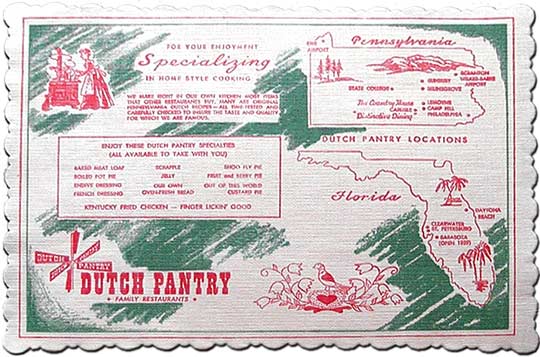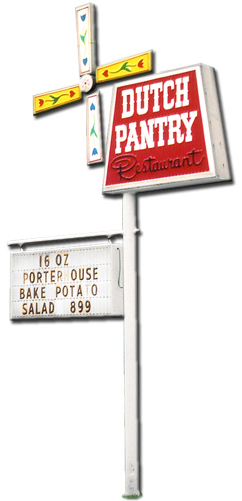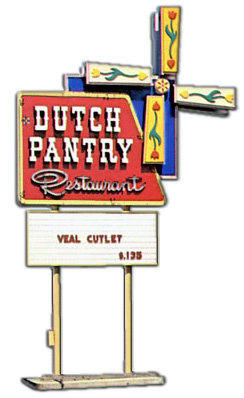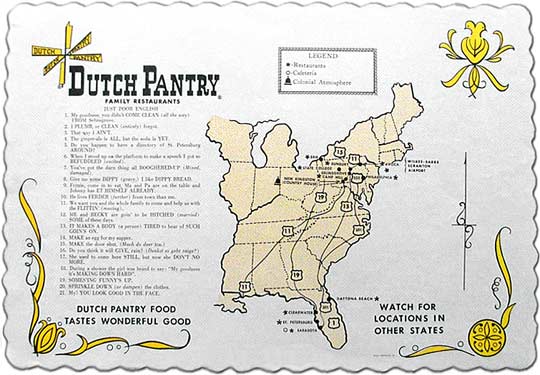Welcomen!
The Dutch Pantry Family Restaurant
chain developed from modest beginnings shortly after
WW II, and then grew utilizing visually unique buildings
meant to resemble Pennsylvania Dutch barns.
Other
keys to success were the chain's standard and reliable
portion controlled fare, appeal to children, and sales
of Pennsylvania Dutch themed gift items.
List
of locations is incomplete.
|
|
|
| |
|
Where
Food Makes Friends! |
|
|
| |
| Troy,
AL |
Bowie,
MD |
Charlotte,
NC |
| Delaware |
Fenton,
MI |
Ohio |
| Florida |
St.
Louis, MO |
Pennsylvania |
| Macon,
GA |
Vestal,
NY |
Arlington,
TX |
| Illinois |
Newburgh,
NY |
Virginia |
| Florence,
KY |
Syracuse,
NY |
West
Virginia |
|
| |
| |
|
|
| |
Der
Distlefink
The
distlefink is a lovely bird,
His song not loud -- nor is it heard,
But he’s our friend, a voice or not,
His
presence here, a happy lot.
Descended
from another age
This “Golden Finch” was once the
rage.
Admired and loved by mass decree,
By folks in Prussia and Germany.
A symbol of pride, good fortune too,
As all good Dutchmen, he grew and grew.
The
second head he bears so well,
Is there so everyone can tell,
That he protects us with a knack,
With one head in front, and one in back.
Poem
on the children's menu offered free
dessert when the kiddies recited it
from memory! Submitted by Denny Kelly. |
|
|
| |
|
Above:
Pennsylvania
Dutch motifs were used extensively in Dutch
Pantry's advertisements. However even as the
region's inhabitants were "German,"
a Dutch windmill likeness came to be the chain's
logo! |
| |
|
|
America's
Original Country Cookin' |
An
outgrowth of Lottie Kemberling's farm fresh foods, she
and her son Jess M. Kembering opened their first Dutch
Pantry Restaurant in 1945 along U.S 11 near Selinsgrove,
Pennsylvania. Mrs. Kemberling said that the name of
her restaurant was derived from the Pennsylvania Dutch
region with its German descendants and their unique
culture. More directly, the name Dutch Pantry referred
to the notion that every Pennsylvania Dutch home contained
a large pantry stocked with good food!
The
chain gradually expanded during the 1950s and 1960s
with additional units in Pennsylvania
and then in Florida.
The enterprising family soon caught the franchising
bug which allowed steady growth by the end of the 1960s.
A standard restaurant design was settled upon with an
image that reflected the food and atmosphere of the
Pennsylvania Dutch country. The buildings, said to simulate
colorful Pennsylvania Dutch barns, were facadism at
its best. Exteriors were decorated with hex signs, roofed
with eye-catching red and white porcelain enamel tiles,
and topped with exaggerated cupolas. The restaurants
were fanciful caricatures of Pennsylvania Dutch barns!
The
standard restaurant interior featured a luncheon counter,
and two dining rooms flanking a country store merchandising
area that sold candy and gift items. The interior was
rustic with rough hewn beamed ceilings, handcrafted
furniture, and a large cast iron stove--all said to
create an old fashioned kitchen atmosphere (reminiscent
of modern day Cracker Barrel Restaurants). The experience
was geared to family dining and featured a wide menu
selection, and offered an award winning unique children's
menu.
As
the chain evolved, food items became standardized and
portioned controlled. To ensure quality most food was
prepared at a central commissary--first called Lottie's
Kitchen and then renamed Kemberling's Foods. In addition
to the central kitchen a training facility called Dutch
Pantry University was created to provide management
training in all phases of Dutch Pantry operations. A
corporate ownership change in the early 1970s resulted
with Dutch Pantry in the hands of C.P.C. International
which made Knorr soups and Mazola oil. C.P.C. had grand
plans for the chain and projected 300 Dutch Pantrys
for the U.S. and Canada by 1972. Although the chain
did grow and attracted large franchise holders like
Standard Oil of Ohio (SOHIO) and later allowed for existing
buildings to be converted into Dutch Pantry Restaurants
by other franchisees, the goal of 300 units was never
attained. |
| |
|
|
In
1983 there were 52 restaurants in 12 states, but by
then the chain was in steady decline. Many of the
locations were owned by the Helmsleys and when SOHIO's
successor Rains International failed to pay the rent,
eviction proceedings began. During the late 1980s,
the chain utterly collapsed and restaurants were closed,
converted, and demolished. By the 2000s only a couple
remained operating, and they tenuously hung on to
the Dutch Pantry goal--to transport a picturesque
patch of Pennsylvania Dutch countryside no matter
where thay are. |
|
|
| |

| Placemats--above
1959, below ca. 1960s: Kummerlowe Archive |
| |
| Above
& Below: With its origins in Pennsylvania following
WW II, outlets began popping up in Florida during the 1950s.
A not uncommon practice, several chains operated units in
the Sunshine State as distant outliers.
Dutch
Pantry was a Kentucky Fried Chicken franchisee. That is
to say, prior to the creation of KFC restaurants, individual
restaurateurs and chains served Colonel
Sanders' secret recipe chicken in addition to whatever
other specialties they may have offered. Note that the Sarasota
Dutch Pantry opened in 1959 and was cafeteria style. Moreover
Dutch Pantry also operated a restaurant called New Kingdom
which featured a colonial atmosphere. |
|
| |
|
| |
| |

Williamstown,
WV--Phil Edwards |
|

|
|
|
| bernert |
| Wolverine
Porcelain Enamel brochure ca. 1960s: Courtesy of Tim & Tom
Bernert |
| |
Red
& White Glasiron Roofs Identify the Dutch Pantrys --
produced by the Wolverine porcelain enamel company, the red
and white roof tiles were described as fade proof, rustproof
and otherwise indestructible. Several other chains as well
as independent operators employed the eye-catching porcelain
enamel roof tiles including Howard Johnson's, Dobb's House,
and Krispy Kreme. |
| |
Above:
The Dutch Pantry shown in Wolverine's propaganda may have
been the unit in Selinsgrove.
It was likely a one-off prototype with its design influenced
by the optimism of the space age. With its sleek lines and
stylized cupola it doesn't really invoke the Pennsylvania
Dutch countryside, rather it looks "Barn-Moderne!" |
|
| |
| |
|
| |
|
The
Glory of
the House is Hospitality |
HMI
was sold to the
"Queen of Mean" in 1980, and then she sold
the chain along with other property in 1999. |
|
| Matchbook
ca. 1970s: Kummerlowe Archive |
|
|
| |
|
|
| donahue |
Hospitality
it's more than just our name!
Standard Oil of Ohio (SOHIO) created Hospitality Motor Inns
(HMI) as a subsidiary in 1964. SOHIO's idea was to increase
its market share by adding divisions that it felt were related
to its core gasoline business. Its first motor inn was an
exceptionally modern and well-planned 159 room property located
in Willoughby, a suburb of Cleveland. Later the chain was
moved upscale with the addition of at least four Ambassadors
Row hotels.
|
| 1980
Hospitality Motor Inns directory: Courtesy of Dan Donahue |
|
| |
Dutch
Pantry entered the picture in 1967 after SOHIO through HMI
became the chain's largest franchisee. its first Dutch Pantry
opened in Wadsworth just outside of Akron in 1968. HMI became
a public company in 1972 and was sold to Harry and Leona Helmsley
in 1980 for $36 million. After the sale the motor inns promptly
became Harley Hotels. Meanwhile the Helmsleys retained ownership
of HMI's 35 Dutch Pantrys in five states, but did not operate
them. Instead it leased the restaurants to an outfit based
in New York called Rains International. |
|
| |
Below:
The unidentified location shown in a generic postcard exemplified
the chain's fully realized style and design which reached
its zenith during the latter 1960s and early 1970s. |
| |
| Postcard
ca. 1970: Kummerlowe Archive |
|
| |
|
| |
| References
and Sources: |
| |
| Advertisement
(Tampa Tribune or St. Petersburg Times?) Aug.
1966 (provided by Robby Delius). |
| |
| “Charleroi
Has a Lot to Offer Industry.” The Valley Independent/The
Valley Bonus 6 June 1983, 9. |
| |
| “Dog
House Chain Has New Owners.” The Independent Pasadena
Star-News 17 May 1968. |
| |
| Donahue,
Dan. Correspondence concerning Hospitality Motor Inns 1 Dec.
2007. |
| |
| Dotson,
Dan. “SOHIO timeline.” Official, Unofficial SOHIO
Site. Retrieved 4 Dec. 2007 from http://www.dantiques.com/sohio/sohioan/1-1970.htm |
| |
| Dotson,
Dan. “SOHIO Expands into Hotel, Restaurant, and Truck
Stop Operations.” Official, Unofficial SOHIO Site. Retrieved
4 Dec. 2007 from http://www.dantiques.com/sohio/timeline.htm#dis |
| |
| Dutch
Pantry/Hospitality Motor Inns directories circa 1980 (provided
by Dan Donahue). |
| |
| “Dutch
Pantry Eating Units Set for Ohio.” Coshoton Tribune
26 June 1967. |
| |
| “Dutch
Pantry Opens Monday.” Clearfield Progress 24
Nov. 1973, 6. |
| |
| “Dutch
Pantry Sales up 33%; Renovation.” The Valley Independent
30 April 1984, Sec. C. |
| |
| "Dutch
Pantry Sets Opening Date." Lima News 23 April
1975, 30. |
| |
| "Dutch
Pantry to Open in Speers" The Valley Independent [Monnessen]
12 May 1978, 10. |
| |
| "East
Side Retail Business Increasing," Lima News 8
Dec. 1974, C10. |
| |
| Gardner,
Bob. “Solutions are Sought to Restaurant Closing.”
The Valley Independent [Monnessen] 17 April 1987, A5.
|
| |
| Get
Wild About Clearfield County 2007. Clearfield Recreation
and Tourism Authority brochure 2007. Retrieved 4 Dec.
2007 from http://www.visitclearfieldcounty.org/Travelguide/guide.pdf |
| |
| Groth,
John C., Paul D. Phillips, R. Malcolm Richards. "Financing
the Alaska project: The Experience at Sohio," Financial
Management, Vol 8 No 3 Autumn 1979 pp 7-16. |
| |
Helmsley,
Leona (Mindy). (n.d.) The Unabridged Hutchinson Encyclopedia.
(2004). Retrieved 4 Dec. 2007 from http://encyclopedia.farlex.com/Helmsley,+Leona+(Mindy) |
| |
| “Ivan
E. Wilson to Manage New Mansfield Dutch Pantry Restaurant.”
The Wellsboro Gazette 27July 1967, 5. |
| |
| Jackle,
John A, Keith A. Sculle. The Gas Station in America. Baltimore,
MD: The Johns Hopkins University Press, 1994. (see
note below) |
| |
| Kelly,
Denny. Correspondence concerning the now demolished S. Dirkson
Parkway Dutch Pantry restaurant in Springfield, IL and the children's
menu poem, "Der Distlefink," that his then 5 year-old
daughter memorized for a free sundae--a story which became a
part of his family's lore, Jan 12, 2008. |
| |
| "Meristar
Hospitality Corp. Amended Annual Report (10-K/A) Item 10: Directors
and Executive Officers of the Registrant filed 6-5-98,"
EDGAR Online, Inc. Retrieved 4 Dec. 2007 http://sec.edgar-online.com/1998/06/05/15/0000930661-98-001307/Section15.asp |
| |
| Pantages,
Larry. “Eviction Action Against Dutch Pantry Operator.”
The Akron Beacon Journal 20 Aug. 1985, B5. |
| |
| "Park,
Office Restaurants Planned at Higgins-Rte. 53" Chicago
Daily Herald 15 July 1977, sec. 2. |
| |
| “Pumpernickel's
for a Change; A Unique Meal in a New Decor.” The Wellsboro
Gazette, 11 Aug. 1982, 6. |
| |
| “Putnam
Co. Opens New Dutch Pantry.” The Wellsboro Gazette,
8 Nov. 1973. |
| |
| "Glasiron
Porcelain Enamel Shingles by their Roofs you know them."
Wolverine Porcelain Enameling Co. circa 1960s (provided by Tim
& Tom Bernert). |
| |
| "Shoney's
Restaurant Buys Dutch Pantry." The Orlando Sentinel
21 Aug. 1989. |
| |
| “Sohio
Builds Dutch Pantry Restaurants.” Coshoton Tribune
10 Oct. 1967. |
| |
| “Standard
Oil Co. Plans Operation of Restaurants.” The Van Wert
Times Bulletin 29 Aug. 1968. |
| |
| “Table-Hopping.”
Syracuse Herald Journal 17 Sept. 1976. |
| |
| Weirick,
Joel. Correspondence concerning Lottie and Jess Kemberling,
their founding of the chain, Florida expansion, the 1963 Selinsgrove
fire, penning of the "Der Distelfink" poem, sale of
the company to Best Foods in the late 1960s, and many happy
childhood memories of his family's chain, Jan 30, 2008. |
| |
|
| |
| Photo
& Image Credits: |
| |
|
| |
|
| note |
| Notes: |
| |
Jackle
& Sculle authors of The Gas Station in America incorrectly
state on page 72 of their opus that Standard Oil of Ohio (SOHIO)
flirted with motel construction through their L & K motel
subsidiary. While there was a chain of L & K motels which
had a substantial presence in Ohio which included "friendly
L & K Restaurants," the chain was not related to
SOHIO and the authors must have confused L & K with Hospitality
Motor Inns. |
| |
|
| |
| The
purpose of this site is informational. It is neither commercial
nor representative of any brand, company, or business. Any trade
names, trademarks, etc. that are depicted remain the property
of their respective owners. Please contact this site's owner
prior to reproducing any part of it. Works from contributors
(includes photographs, ephemera, etc.) lent to highwayhost.org
and any of its affiliated sites may not be reproduced without
their consent. |
|
|

